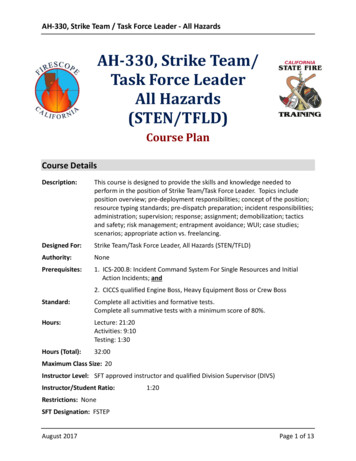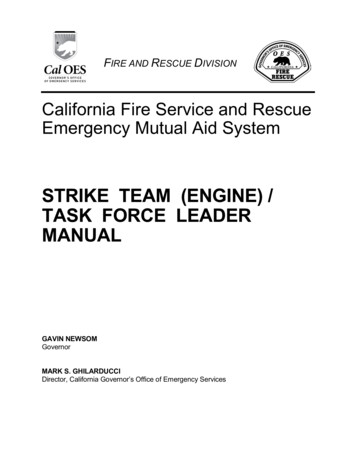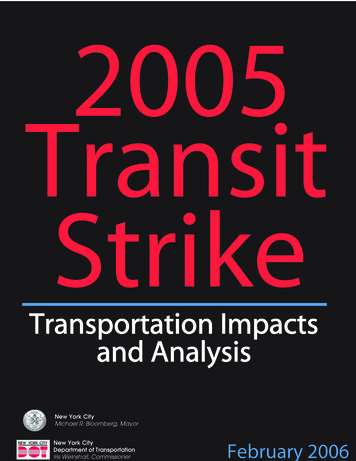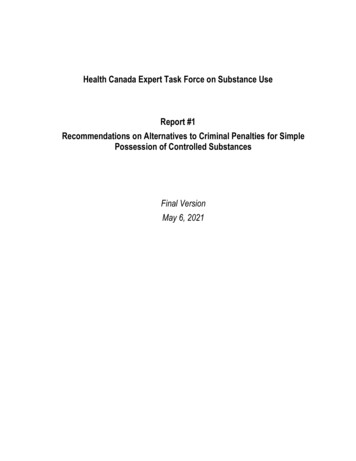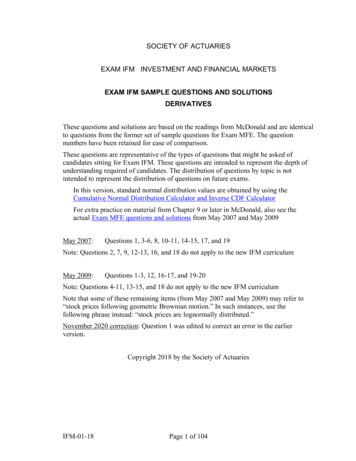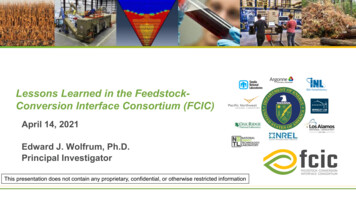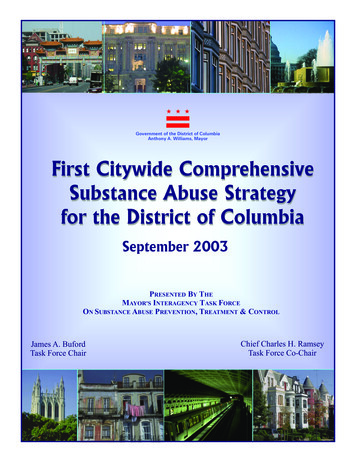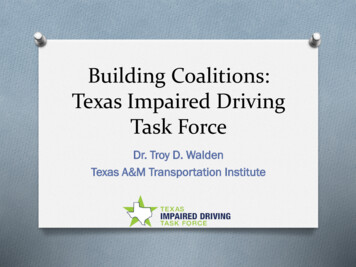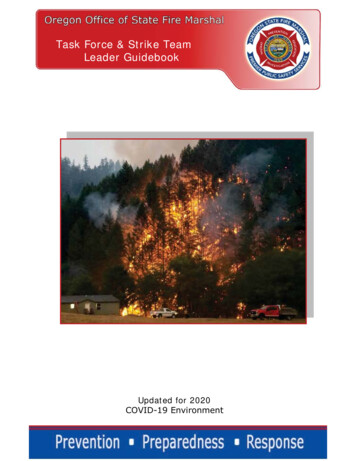
Transcription
Task Force & Strike TeamLeader GuidebookUpdated for 2020COVID-19 Environment
Table of ContentsCode of Conduct1Expectations for all Responders1Task Force/Strike Team Leader Expectations3Checklist 1 – Assembly5Checklist 2 - Arrival6Checklist 3 - Demobilization7OSFM Structure Protection Guide8Sprinklers18Flagging19Forms Overview20Form – Task Force/Strike Team Resource Form21Form – Resource Manifest22Form – Apparatus Form23Form – ICS-214/Unit Log24Form – Incident Demobilization Inspection25Form – Engine Company or Crew Performance Rating26Form – Task Force After Action Review27Standard Incident Communications Plan29Wildland Fire COVID-19 Screening Tool30Apparatus Cleaning31
Code of ConductIt is the duty of personnel mobilized by the State of Oregon to maintainhigh standards of performance and conduct that will promote public trustand provide the best possible service to Oregon. Personnel are expectedto demonstrate cooperation, efficiency, integrity, and accountability in theperformance of their duties. It is expected that all mobilized resourceswill conduct themselves in a professional manner, meet the performancestandards for their position, and comply with all local, state, and federallaws.Your actions, behavior, and work ethic will be scrutinized by those withwhom you work and interact and by the citizens being served. Yourepresent the State of Oregon, your region, and your department as anindividual and as a team member on the fire line, in camp, and in transit.Work hard, learn as much as you can, and come home safe.Failure to conduct yourself in the appropriate manner could result in yourimmediate relief from duty.Specific Expectations for All RespondersPublic information: any release of photographs, data, or informationwithout the approval of the IMT is a violation of the chain of commandand such action is subject to disciplinary and possibly legal action. Thisincludes but is not limited to the press/media, text messaging, and anyother forms of communications or social media.Adhere to applicable safety standards. All mobilized individuals have aresponsibility to each other to be alert to and communicate all safetyhazards or near misses to the immediate supervisor or the IncidentManagement Team. All injuries incurred while mobilized must bedocumented and immediately reported to your supervisor.Adhere to the chain of command. Become familiar with whom you areworking, follow directions, and keep your supervisor informed. You areresponsible for understanding your assignments and instructions; if indoubt, immediately ask for clarification.Drive apparatus in a safe and courteous manner at all times. Use allappropriate safeguards, including backing guides. Be considerate ofcivilian traffic. If traffic is backing up behind your convoy, pull off at thefirst safe place and allow traffic to pass. All resources are expected toobey posted speed limits and warnings at all times.Wear your PPE when assigned and appropriate attire when in camp.pg. 1
Maintain a state of readiness at all times. When not assigned, resupplyapparatus and restore equipment. You are expected to be available andready to respond on notice, 24 hours a day.Harassment of any kind against coworkers, supervisors, civilians,contractors, or others based on race, color, national origin, age, gender,disability, religion, marital status, or any other class protected by civilrights laws will not be tolerated and will result in immediatedemobilization.When not assigned or in camp, conduct yourself in a manner that will notdiscredit yourself, your department, or the State of Oregon.Misconduct, insubordination, dishonesty, inattention to duty or anyconduct that you know or should know is improper will not be toleratedand may result in immediate demobilization from the incident.Know and follow the procedures in the current Oregon Fire ServiceMobilization Plan.Access to a cache and requests for supplies shall be only through yourchain of command. Return all procured equipment prior todemobilization. You may be responsible for items not returned.Alcohol and illegal drugs shall not be transported or consumed. A personusing prescription drugs may be asked to show reasonable proof that themedication is prescribed to them. Consuming over-the-counter orprescribed medication must not interfere with a person’s performance orjudgment.Firearms are not allowed unless it is a requirement of your assignedposition.You are required to report to your immediate supervisor any medicalcondition that may arise that will interfere with your ability to safelyperform your assigned tasks.Excerpted from the 2019 Oregon Fire Service Mobilization Planpg. 2
Task Force/Strike Team Leader ExpectationsWhile you are working on this incident, you are asked to adhere to thefollowing guidelines. Providing for public and firefighter safety is alwaysour number ONE priority.Attend the Operations Period Briefing (Be on Time)x Meet with your Division/Group Supervisor (DIVS) in the appropriateDivision Breakout immediately after the briefing to receive anddiscuss specific details of your assignment.x You are responsible for understanding your assignment andobtaining all necessary information, maps, and an Incident ActionPlan (IAP) for each apparatus.x While you are at briefings, your personnel are expected to bepreparing to start work; obtaining meals, water, ice, radio cloning,fuel, etc. Your resources should be prepared to begin workimmediately following the Division Breakout.x Ensure each apparatus officer completes and submits an ICS 214(Unit Log) for each operational period. You will submit Unit Logs foreach apparatus and yourself to the DIVS after each operationalperiod.Before Leaving the Incident Basex Brief all personnel assigned to you.x Ensure that your assigned resources have all necessary equipmentand documentation to understand their assignments.x Check with your DIVS on the status of anything ordered the day priorto determine delivery time and location.Upon Arrival at your Assigned Divisionx Account for all resources assigned to you.x Debrief with the out-going DIVS or Task Force Leader.x Personal protective equipment is mandatory for everyone on the line.x Identify LCES (Lookouts, Communications, Escape Routes, andSafety Zones) and insure that they adequate. You must do thissoon after arrival and brief all your personnel!During the Operational Periodx Account for all resources assigned to you at all times.x Document any actions, accidents, or agreements in your Unit Logand notify your DIVS when appropriate.x Make sure your activities are well coordinated with your adjoiningDivisions. Share resources when and where appropriate.x Meet with your DIVS before 1400 (day shift) or 0200 (night shift) torequest any resources, supplies, or equipment needed for the nextoperational period.pg. 3
xxxxUpdate your DIVS on fire and weather conditions as appropriate.Develop contingency tactics, and always have alternate plans inplace.Make notes that may be relevant to complete evaluations and anAfter Action Review prior to demobilization. Unsatisfactoryperformance will not be tolerated; it is to be identified and dealt withimmediately. If you are unable to resolve the performance problem, itshall be brought to the attention of the DIVS. Outstandingperformance needs to be documented and recognized. Be preparedto make recommendations on what type of recognitions might beappropriate to the DIVS.All accidents or injuries must be documented and reportedimmediately.Before Leaving the Assigned Divisionx Account for all assigned resources.x Debrief with the in-coming DIVS or Task Force Leader.Upon Returning to the Incident Basex Ensure that all of your assigned resources have returned to campand are accounted for.x Debrief with your DIVS.x You are to be available to return to work 24 hours a day.Internal/External Political ConcernsThe needs of the local jurisdiction and community must be an importantconsideration in all interactions. Ask your DIVS how you can cooperatewith the Incident Information Officers when you come in contact withcommunity members or media.pg. 4
Task Force/Strike Team Leader Mobilization Checklist #1FOR ASSEMBLING THE TASK FORCE/STRIKE TEAMPersonnel and apparatus that do not meet the response standards of theMobilization Plan may be rejected by the Incident Commander withoutstate reimbursement for travel or any other response costs.Assemble Task Force/Strike Team (TF/ST) at Point of Departure.Brief all personnel on code of conduct and expectations.Confirm all personnel have adequate personal gear for a minimum ofseven days and are self-sufficient for 72 hours with adequate food,drinking water, and sleeping bags.Ensure all personnel conduct self-screening using the Wildland FireCOVID-19 Screening Tool.Confirm all personnel are fit for duty.Confirm all personnel are properly trained and equipped withappropriate structural, wildland, or other necessary PPE for the typeof incident to which you are responding.Confirm all apparatus meet applicable standards, are properly andadequately equipped, in good repair, and capable of meeting traveland firefighting requirements.Confirm all apparatus have the ability to utilize State Fire Net.Confirm all apparatus are fully fueled and personnel have travelfunds.Complete and submit a TF/ST Resource Form to the AOC.You must receive explicit approval from the AOC.Ensure one Resource Manifest Form is completed for eachapparatus, including command and support apparatus.Ensure one Task Force/Strike Team Apparatus Form has beencompleted for each apparatus.Brief all personnel on incident, travel route, communications en route,pre-determined fuel or rest stops, safety issues, and second-incommand.Advise AOC of departure time, travel route, and estimated time ofarrival. (503-373-0001)Ensure that each apparatus uses the same departure time on theirResource Manifest.Prior to arrival at the incident, ensure all apparatus are fully fueledand ready to begin operations. This final fueling is not reimbursable.pg. 5
Task Force/Strike Team Leader Mobilization Checklist #2FOR TASK FORCE/STRIKE TEAM ARRIVAL AT AN INCIDENTPersonnel and apparatus that do not meet the response standards of theMobilization Plan may be rejected by the Incident Commander withoutstate reimbursement for travel or any other response costs.Prior to arrival at the incident, ensure all apparatus are fully fueledand ready to begin operations. This final fueling is not reimbursable.Advise AOC of arrival time. (503-373-0001)Arrive at requested time and location. Collect Resource Manifestsand Apparatus Forms. TFL ONLY don mask and meet ResourceUnit Leader (RESL) at designated location to complete check-in.Initiate ICS-214s (Unit Logs) for each apparatus. Complete this formdaily and provide to Division/Group Supervisor (DIVS). Documentactions, accidents, agreements, and other relevant information.Determine availability and location of food, water, and fuel.Determine location of sleeping areas. Find a safe, comfortable, andquiet place for the TF/ST to sleep and establish camp.Visit Communications Unit and ensure all apparatus have radios withincident communications plan.Confirm your group has access to systems or paperwork to completestructural triage work (paper forms or electronic system).Determine what level of medical care is available, its location, andhow to access it.Locate your DIVS and obtain your initial assignment and/or briefing.Confirm how to contact them.Find out where and when operational briefings occur and be on timefor briefings. Attend all briefings; get updated maps, and IncidentAction Plans (at least one per apparatus).When possible, debrief with the Task Force/Strike Team Leader(s)you are relieving.“How can we accomplish this task while minimizing human contactor contact where humans have recently been?”pg. 6
Task Force/Strike Team Leader Mobilization Checklist #3FOR DEMOBILIZING THE TASK FORCE/STRIKE TEAMEnsure all damage claims have been reported to Division/GroupSupervisor (DIVS) and documented appropriately.Each apparatus operator must complete Incident DemobilizationVehicle Safety Inspection Form. Any failed items must be reported toDIVS.Ensure all ICS-214s (Unit Logs) have been given to DIVS.Ensure the return of all borrowed equipment and resources to theappropriate party.Complete evaluations for all resources assigned to you.Receive evaluation from DIVS.Complete Task Force After Action Review.Ensure all personnel have sufficient rest prior to demobilization.Make sure all apparatus are fully fueled.Brief all personnel on travel route, communications en route, predetermined fuel or rest stops, safety issues, and second-in-command.Check out with the Resource Unit Leader (RESL). Provide RESL withDemobilization Vehicle Safety Inspection Forms, evaluations, TaskForce After Action Review Form, and any other documentation youhave. RESL must sign all Manifests and return hard cards.Advise the AOC of departure time and ETA. (503-373-0001)Advise the AOC and your Fire Defense Board Chief of arrival. (503373-0001)Each apparatus must record their in-station time on their Manifest.“How can we accomplish this task while minimizing human contactor contact where humans have recently been?”pg. 7
Oregon State Fire MarshalStructure Protection GuidePURPOSEThis structural protection plan is designed to provide structural resources with common expectations,procedures and terminology in order to execute efficient structural protection during wildlandfire/urban interface incidents.PROCEDUREThe components of effective structural protection are based on the integrated actions surroundingthree critical actions; Structural Triage, Structural Preparation and Defensible Tactical Action. Thesuccessful implementation of these actions is based on the following critical factors: TIME,RESOURCES and FIRE CONDITION. These factors must be strongly considered in the decisionmaking of when and how to execute the critical structure protection actions.I.Structural TriageUtilization of the OSFM Structural Protection Checklist should be utilized when triaging structureswith the goal of placing each structure in one of the following categories. These categories will beutilized to determine the structural prep and defensible actions given consideration of available time,resources and fire condition.Defensible – Stand Alone (Low Risk)Safety zone presentRequires little or no attentionWill require patrol orhomeowner presence afterfire passageDefensible – Prep and Hold (Moderate Risk)Safety zone present at or nearstructure for apparatus andfirefightersStructure has a higher probabilityof ignition without firefighterinterventionPrep and Go (High Risk)No safety zone presentIf time allows, rapid mitigation, applyfoam or gelSet trigger point for safe retreatGo to nearest safety zone, return toarea after fire passageCheck and Go (Extreme Risk)No safety zone presentInadequate time for mitigationsIf time allows, ensure lives are notthreatenedSet trigger point for safe retreatGo to nearest safety zone, return toarea after fire passagepg. 8
II.Structure PreparationStructural preparation is executed based on the Structural Protection Checklist and is a factor ofTIME, RESOURCES and FIRE CONDITION. If a fire front is imminent or highly likely the goal isto defend what can be saved and accomplish as much of the Structure Prep Priorities as feasiblypossible. This section is intended to provide structural protection resources with a clear guideline ofwhat structure prep objectives are expected based on the mode of operation. This is a criticalcomponent of the structure prep plan, if there are other actions not addressed in this plan it isrecommended that those actions are discussed with the appropriate supervisors.Prioritize Structural Prep Actions based on the greatest chance of savability. Complete prep actionson the structures using the following order.1.2.3.4.Low Risk- Stand Alone. Reinforce and ensure prepped for standalone defense.Moderate risk- Prep and Hold. Time sensitive, these structures provide biggest gains.High Risk- Prep and Go. Time sensitive.Extreme Risk- Check and GoStructure Prep PrioritiesThe following outlines the order of priority in which preparation should be conducted. Two generallevels of structure prep are identified: Surface Prep and Full Prep. The three critical factors of time,resources, and fire condition will determine which level and priority should be accomplished. Thisdetermination may occur in conjunction with the Division/Group Supervisor.Depending upon these critical factors, attempt to accomplish as much as feasibly possible startingwith Surface Prep priorities down through the Full Prep priorities. The ultimate goal with any ofthe following prep work is to minimize ore eliminate the direct flame contact to the edge of acombustible building material.SURFACE PREPShould always be completed first. Allows crews to conduct initial prep work withoutphysically altering structures or property providing crews opportunity to conduct work if firefront is not imminent and it is unclear if fire front will affect the area.Priority #1Priority #2Priority #3ROOF (critical ignition component)xClean out gutters and ember traps at the vertical intersections andhorizontal surfaces, remove receptive fuel beds, leaves, needles,debris and any other flammable materials on or attached to theroof.xFlush gutters with water and plug down spouts.INTERIORxClose windows.xTurn lights on, close interior doors and unlock and shut exteriordoors.EXTERIORxRelocate easy to move flammable/combustible items surroundingstructure (lawn furniture, toys, propane cylinders, gas cans etc.) toan area of cover or outside preparation perimeter (garage, shed,barn etc.).xClear decks, walkways and other areas of light receptive fuels(leaves, needles ect.). Consider base of exterior walls, decks orother areas of adjoining combustible surfaces of the structure.pg. 9
FULL PREPComplete Surface Prep priorities first and then determine which of the following Full Preptasks need to be/can be completed.Priority #4EXTERIORxRemove receptive fuels adjacent to the structure 5-10 feet (finedead fuels, leaves, grass, bark dust, firewood, etc).xCover attic and basement vents. (metal window screen ispreferable).xShut off gas, LP/NG.Priority #5SECONDARY PRIORITIESxRemove vegetation within 30 feet of structure scatter flat.xLimb trees 5 to 7 feet from ground.xRemove debris and ember traps around structure.xRemove lawn furniture and toys- place in home if possible.xRemove attached fences 10 feet from structure for access andremoval of combustibles.xRemove and scatter wood pile or cover to avoid ignition by embershower.xMove cars if possible.xConstruct handline around structure, outbuildings, or immovablefuel sources/hazards.xConsider burn out operations.xConsider use of sprinkler kits. Only if adequate structural prephas been obtained.xConsider use of structure wrap.xConsider extreme prep tactics (additional limbing or falling oftrees).xConsider egress preparation. Limbing/brushing 5 to 10 feet oneither side of road/driveway.xConsider the need for Temporary Refuge Area (TRA) and/orSafety Zone preparation.FIRE IMMINENTConsider when fire front is imminent and structure is categorized as defensible.xDetermine defensible action.xStretch hose lines.xLadder roof, hose to roof.xInitiate Structural Prep Checklist if not already completeComplete as much as possible before initiating defensible stand.xConsider burn out operations.pg. 10
III.Defensible Tactical ActionThe following tactical actions allow firefighters combating an urban interface wildland fire to utilizecommon terminology and actions in order to safely and effectively defend structures.Primary Tactical ActionPrimary tactical actions are based on the triage category and level of structure prep accomplishedprior to arrival of fire front. Primary tactical action may be supplemented or transition to anotherprimary action or secondary tactical action as needed.1.STAND ALONETriage Category: Defensible (Low Risk)- Purpose: Adequate safety zones and escape routes allow for safe and effectivepreparation and defensible stand.- Indicators: Structure requires little or no preparation or protection.- Actions: Ensure adequate structural preparation measures are in place. If neededmake defensible stand as fire front approaches.- Considerations: Situational awareness. Tactical patrol before and after fire front.Increased possibility of occupants holding in place.2.PREP & DEFENDTriage Category: Defensible (Moderate Risk)- Purpose: A tactic used when it is possible for fire resources to stay and defendstructures as the fire front arrives.- Indicators: Safety zones, escape routes and TRAs are present and adequate timeallows for safe preparation of structure for defense prior to fire front impact.- Actions: Aggressive structure prep following Structure Prep Checklist. Adequatetime, resources and conditions to make a defensible stand as fire front approaches.- Considerations: Situational awareness, escape routes and safety zones must beidentified and maintained. Utilization of PACE planning in case of adverse firebehavior changes. Fire behavior must allow for firefighters to safely remain inplace and engage the fire.pg. 11
3.PREP & GOTriage Category: (High Risk)- Purpose: No safety zone present.- Indicators: Time allows for rapid mitigation measures.- Actions: Rapid triage, prep and retreat to Safety Zone or TRA.- Considerations: Set trigger point for safe retreat and return tactical action.pg. 12
4.CHECK & GOTriage Category: (Extreme Risk)- Purpose: Inadequate defensible space prohibits safe defense actions.- Indicators: Extreme fire behavior, compressed time constraints.- Actions: Rapid evaluation to check for occupants who may require removal orrescue, then withdraw to a Safety Zone or TRA.- Considerations: Retreat and return tactical action when able.pg. 13
Secondary Tactical ActionSecondary tactical action should be utilized to supplement and support the primary tactical action.1.RETREAT & RE-ENGAGE- Purpose: Follow up tactic used when Check and Go, Prep and Go or Bump andRun tactics are initially used.- Indicators: When there is insufficient time to safely set up ahead of the fire or theintensity of the fire would likely cause injury to personnel located in front of thefire.- Actions: After retreating to TRA or Safety Zone, return behind the fire front tosearch for victims, minimize property loss, effect perimeter control, extinguish hotspots around structures, control hot spots and reduce ember production. Checkareas that are known ember traps, under decks, under houses, gutters, flowerbeds/bushes, and sheds.- Considerations: Adequate TRA and/or safety zonepg. 14
2.ANCHOR & HOLD- Purpose: Defend exposures, stop structure to structure ignitions, reduce emberproduction and extinguish structure fires.- Indicators: Primary mechanism of fire spread is STRUCTURE to STRUCTUREin common neighborhoods or commercial areas.- Actions: Tactical utilization of control lines and large water streams from fixedwater supplies.- Considerations: Only utilized when water supplies are abundant. Utilization ofgels and class “A” foams to assist in mop-up and prevent secondary ignitions.pg. 15
3.BUMP & RUN- Purpose: Often used when inadequate resources are available to conductperimeter control or other structure defense tactics.- Indicators: Defensive tactic when fire front impact is imminent. Offensive tacticwhen resources are attempting to steer the fire to an established end point whereother resources have prepared control lines. Structure prep is minimal due tocompressed time constraints.- Actions: Resources move ahead of the fire front to extinguish spot fires, hot spotsand defend structures. Resources remain mobile, able to maneuver quickly,leapfrogging from one structure to another.- Considerations: Situational awareness and utilization of PACE Planning. Mayinvolve direct attack with fireline and firing operations. FFs must move ifstructures become involved and quick knockdown cannot be achieved.Utilization of additional resources behind “bump and run” for perimeter controland tactical patrol.pg. 16
4.TACTICAL PATROL- Purpose: Tactic used before or after fire front that relies on mobility of assignedresources to continually monitor assigned areas- Indicators: Before or after fire front in which the fire may pose a risk tostructures from fire brands or smoldering combustibles in void spaces, roofs, inrain gutters and stored material near buildings. Also, in areas away from the firein which there is predicted to be significant ember showers and there is anaccumulation of receptive fuels.- Actions: Patrol area where the fire has passed but there is still a risk to structuresfrom fire brands- Considerations: Patrol areas downwind of potential ember showers. This tacticshould also be considered to extinguish hot spots (mop up) or secondary structureignitions, and address safety issues such as power lines, hazard trees and otherhazards. Check areas that are known ember traps, under decks, under houses,flower beds/bushes, and sheds.pg. 17
SPRINKLERSWhen ordering a sprinkler kit, also order a pump kit.AdvantagesxUseful where resources cannot stay to defend the structure due to:1. Egress - narrow one lane roads; no easy turn around2. Erratic or extreme fire behavior3. Resource shortage- not enough engines to assign one engine to everystructurexCreates a micro climate around protected resourceDisadvantagesxCannot replace firefighters on the groundxTakes time to installxLag time from order to arrivalxEquipment intensiveSPRINKLER KIT CONTENTSTOOLSxxxxxxxxxxxxxx1 EA Instructions1 EA Carton, 16” x 14” x 12”1 EA Packsack, Waterproof, w/ Straps1 EA Bag, Cotton, Lunch or Tool, 10” x 24”1 EA Saw, Pruning, 10”1 EA Wrench, Adjustable, 10”1 EA Wrench, Spanner, 11”1 EA Hammer, Claw1 LB Nails, Duplex, Double Head, 16d, 3”12 EA Pin, Panel, Hold down, 8”8 EA Stake w/Clamp, Sprinkler, Metal, 18” x 1” x 1”2 EA Block, Wood 2” x 4” x 6”2 EA Cord, Nylon, 1/8” x 100 ft12 Tie Wraps, One Way, 15” - 17”WATER HANDLINGx4 EA Pressure regulator, RV 40 -50x5 LG Hose, Garden, Synthetic, 3/4” NH x 50 ftx5 EA Gasket, Garden Hose, 3/4”x1 EA Nozzle, Garden Hose, 3/4” NH, Adjustable, Brassx1 EA Nozzle, Plastic, 60 GPM, 1 1/2”x4 EA Sprinkler Assembly, 1/2”, Sprinkler Heads w/ Couplingsx4 EA Tee, Hoseline, 1 1/2” x 1 1/2” x 1” w/ Capx2 EA Valve, Wye, Gated, Brass, 3/4”x4 EA Valve, Shut Off, Ball, Brass, 3/4” NHx1 EA Reducer, 1 1/2” NH-F to 1” NPSH-Mx4 EA Reducer, 1” NPSH-F to 3/4” NH-Mpg. 18
GUIDELINES FOR SPRINKLER SET UPxWhere possible place the sprinkler high to simulate rain. Structures are designedto resist rain.xAll combustible material that is adjacent to the building or under decks must bewet.xEasily ignited surface material on the building must be made wet and all parts ofa wood roofxAvoid direct hitting of windows and doors or any location that would allow waterto enter the buildingxTest the set up to be sure all sprinklers are working properly and all targetedparts are getting wet.xThe sprinklers do not need to be operated for a long period before the fire arrives(approx. 1 hr), but should be working for the entire fire front passagexProtect the hose lines by burying them or keeping them under sprinklerprotectionxPump sites should be sprinkler protected if they are on vegetation or other fuel.OSFM STANDARD FLAGGINGxRed & white striped with “hazard” printing: general hazardxYellow & black striped with “bees” printing: beesxOrange & black skull & crossbones with “killer tree” printing: hazard treesxBlue with “water” printing: water supplyxHot pink with “escape route” printing: escape routexLight purple with “triaged” printing: triaged structuresoxWrite date, time, & TF identifier on flaggingWhite with “occupied” printing: occupied residences in evacuation areasoWrite date, time, & TF identifier on flaggingHelicopter and Tanker carrying capacitiesTankersSuper Tanker 747VLAT DC-10C-13019,000 gallons12,000 gallons3,000 to 3,500 gallonsScooperSuper Scooper1,000 gallons1,600 gallonsHelicoptersType 1ChinookSkycraneSikorsky S-61 (Croman)BlackhawkK-Max2,400 bucket, 2,800 internal gallon tank2,650 gallons1,000 to 1,200 gallons700 to 1,000 gallons700 to 1,000 gallonsType 2Huey300 to 360 gallonsApproximate gallons per load. All influenced by elevation and weather.pg. 19
FORMS – USE AND PURPOSETF/ST Leaders are encouraged to have copies of the following forms on hand when theyassemble at the Point of Departure (POD).Task Force/Strike Team Resource Form (Pg 21)This form is submitted to the AOC for approval prior to mobilization to an incident. This formwill provide information about the incident and TF identifier. All apparatus and personnelmust be included on this form and it should align with the Manifests provided during checkin.Resource Manifest Form (Pg 22)The Manifest provides the information required by OSFM to reimburse local departmentsfor their participation in mobilizations. Each mobilized unit (engines, command, andsupport) must have their own Manifest. All personnel names and departments must beincluded on this form. Incomplete or inaccurate forms may result in the delay or denial ofreimbursement.The Engine Boss of each responding unit should start their Manifest at the time ofmobilization. Manifest completion is ultimately the responsibility of the TF/ST Leader. Uponarrival, the RESL will collect and verify your Manifests. Upon demobilization, the RESL willuse the form to demobilize the unit and provide a hard-card copy for each apparatus. YourFire Defense Board Chief or the OSFM can supply you with these forms.Apparatus Form (Pg 23)This form is part of the check-in process and is submitted to the RESL upon arrival. Thisform is used by both Safety and Operations.ICS-214/Unit Log (Pg 24)This form is to be c
Table of Contents Code of Conduct 1 Expectationsfor all Responders 1 Task Force/Strike Team Leader Expectations 3 Checklist 1 -Assembly 5 Checklist 2 -Arrival 6 Checklist 3 -Demobilization 7 OSFM Structure Protection Guide 8 Sprinklers 18 Flagging 19 Forms Overview 20 Form -Task Force/Strike Team Resource Form 21 Form -Resource Manifest 22 Form -Apparatus Form 23 .
